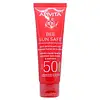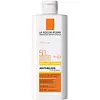What's inside
What's inside
 Key Ingredients
Key Ingredients

 Benefits
Benefits

 Concerns
Concerns

 Ingredients Side-by-side
Ingredients Side-by-side

Water
Skin ConditioningCI 77891
Cosmetic ColorantDiethylamino Hydroxybenzoyl Hexyl Benzoate
UV FilterPropanediol
SolventBis-Ethylhexyloxyphenol Methoxyphenyl Triazine
Skin ConditioningEthylhexyl Triazone
UV AbsorberEthylhexyl Salicylate
UV AbsorberDicaprylyl Carbonate
EmollientC9-12 Alkane
SolventIsoamyl Laurate
EmollientSilica
AbrasiveGlycerin
HumectantCI 77492
Cosmetic ColorantGlyceryl Stearate Citrate
EmollientSodium Stearoyl Glutamate
CleansingPentylene Glycol
Skin ConditioningParfum
MaskingHydrolyzed Algin
Maris Aqua
HumectantChlorella Vulgaris Extract
Skin ConditioningLaminaria Digitata Extract
Skin ProtectingPropolis Extract
Skin ConditioningAchillea Millefolium Extract
CleansingCrithmum Maritimum Extract
Skin ConditioningRosmarinus Officinalis Leaf Extract
AntimicrobialRosa Canina Fruit Extract
AstringentPanthenol
Skin ConditioningAloe Barbadensis Leaf Juice Powder
Skin ConditioningBrassica Campestris Seed Oil
Skin ConditioningSodium Hyaluronate
HumectantBisabolol
MaskingHydrogenated Lecithin
EmulsifyingCoco-Caprylate/Caprate
EmollientTocopheryl Acetate
AntioxidantHydroxypropyl Cyclodextrin
MaskingEthylhexylglycerin
Skin ConditioningDisodium EDTA
Triacontanyl Pvp
HumectantXanthan Gum
EmulsifyingHydroxyacetophenone
AntioxidantCitronellyl Methylcrotonate
MaskingCitric Acid
BufferingCI 77491
Cosmetic ColorantCI 77499
Cosmetic ColorantWater, CI 77891, Diethylamino Hydroxybenzoyl Hexyl Benzoate, Propanediol, Bis-Ethylhexyloxyphenol Methoxyphenyl Triazine, Ethylhexyl Triazone, Ethylhexyl Salicylate, Dicaprylyl Carbonate, C9-12 Alkane, Isoamyl Laurate, Silica, Glycerin, CI 77492, Glyceryl Stearate Citrate, Sodium Stearoyl Glutamate, Pentylene Glycol, Parfum, Hydrolyzed Algin, Maris Aqua, Chlorella Vulgaris Extract, Laminaria Digitata Extract, Propolis Extract, Achillea Millefolium Extract, Crithmum Maritimum Extract, Rosmarinus Officinalis Leaf Extract, Rosa Canina Fruit Extract, Panthenol, Aloe Barbadensis Leaf Juice Powder, Brassica Campestris Seed Oil, Sodium Hyaluronate, Bisabolol, Hydrogenated Lecithin, Coco-Caprylate/Caprate, Tocopheryl Acetate, Hydroxypropyl Cyclodextrin, Ethylhexylglycerin, Disodium EDTA, Triacontanyl Pvp, Xanthan Gum, Hydroxyacetophenone, Citronellyl Methylcrotonate, Citric Acid, CI 77491, CI 77499
Water
Skin ConditioningDimethicone
EmollientC12-15 Alkyl Benzoate
AntimicrobialIsohexadecane
EmollientTalc
AbrasiveStyrene/Acrylates Copolymer
Isododecane
EmollientCaprylyl Methicone
Skin ConditioningDicaprylyl Ether
EmollientTriethylhexanoin
MaskingDicaprylyl Carbonate
EmollientDimethicone/PEG-10/15 Crosspolymer
Aluminum Hydroxide
EmollientStearic Acid
CleansingPEG-9 Polydimethylsiloxyethyl Dimethicone
EmulsifyingPentylene Glycol
Skin ConditioningAlumina
AbrasiveAluminum Stearate
Cosmetic ColorantCaprylyl Glycol
EmollientDipropylene Glycol
HumectantDisteardimonium Hectorite
StabilisingMagnesium Sulfate
PEG-8 Laurate
EmulsifyingPhenoxyethanol
PreservativePolyhydroxystearic Acid
EmulsifyingPropylene Carbonate
SolventSodium Citrate
BufferingTocopherol
AntioxidantWater, Dimethicone, C12-15 Alkyl Benzoate, Isohexadecane, Talc, Styrene/Acrylates Copolymer, Isododecane, Caprylyl Methicone, Dicaprylyl Ether, Triethylhexanoin, Dicaprylyl Carbonate, Dimethicone/PEG-10/15 Crosspolymer, Aluminum Hydroxide, Stearic Acid, PEG-9 Polydimethylsiloxyethyl Dimethicone, Pentylene Glycol, Alumina, Aluminum Stearate, Caprylyl Glycol, Dipropylene Glycol, Disteardimonium Hectorite, Magnesium Sulfate, PEG-8 Laurate, Phenoxyethanol, Polyhydroxystearic Acid, Propylene Carbonate, Sodium Citrate, Tocopherol
Ingredients Explained
These ingredients are found in both products.
Ingredients higher up in an ingredient list are typically present in a larger amount.
Dicaprylyl Carbonate comes from carbonic acid and caprylyl alcohol, a fatty alcohol. It is an emollient and gives skin a velvet feel. The sources of Dicaprylyl Carbonate may be synthetic or from animals.
As an emollient, Dicaprylyl Carbonate creates a film on the skin. This film traps moisture in, keeping your skin soft and hydrated.
Pentylene glycol is typically used within a product to thicken it. It also adds a smooth, soft, and moisturizing feel to the product. It is naturally found in plants such as sugar beets.
The hydrophilic trait of Pentylene Glycol makes it a humectant. As a humectant, Pentylene Glycol helps draw moisture from the air to your skin. This can help keep your skin hydrated.
This property also makes Pentylene Glycol a great texture enhancer. It can also help thicken or stabilize a product.
Pentylene Glycol also acts as a mild preservative and helps to keep a product microbe-free.
Some people may experience mild eye and skin irritation from Pentylene Glycol. We always recommend speaking with a professional about using this ingredient in your routine.
Pentylene Glycol has a low molecular weight and is part of the 1,2-glycol family.
Learn more about Pentylene GlycolWater. It's the most common cosmetic ingredient of all. You'll usually see it at the top of ingredient lists, meaning that it makes up the largest part of the product.
So why is it so popular? Water most often acts as a solvent - this means that it helps dissolve other ingredients into the formulation.
You'll also recognize water as that liquid we all need to stay alive. If you see this, drink a glass of water. Stay hydrated!
Learn more about Water